
We are playing a “hurry up and wait” game. To make it through the Northwest Passage in one season, we have 6,000 nautical miles to travel and less than four months to cover them. So, when the conditions are right, we scamper along, observing the passing landscape through binoculars and relishing our time with curious seals, sea lions and humpback whales. When the conditions aren’t right, we settle in to wait for the next window.
For the first six weeks, it was mostly “hurry,” as we sailed from Seattle, along the coast of Canada and around the southern end of Alaska. Wind and tide regulated our schedule, variables we are accustomed to navigating from our years of sailing in the Pacific Northwest. Using a few built-in buffer days, we stayed on track, moving all but 9 of those first 45 days. It was a familiar route with predictable weather patterns that didn’t slow us down much at all.
But we are no longer in familiar waters negotiating our movement with familiar variables. DogBark! currently rests against the supportive pilings in the harbor of Nome, idle and antsy. She has been stationary for over a week, by far the longest period of inactivity she has seen since leaving Seattle. We have encountered our first “wait.”
The next leg, into the arctic circle, through the Bering Strait, and around Point Barrow (the northernmost point in the USA), will bring us into contact with the unfamiliar and impulsive movements of sea ice. And the sea ice has made it clear that this is not the week to start our negotiations. Our daily ice reports, combined with the skillful analysis from several local authorities and a professional meteorologist, continue to show a coastline east of Point Barrow impeded by ice. This ice actually shrank back from Barrow early this year, yielding a clear path east as early as the beginning of July. But in the normal summer tug-of-war between cold north winds piling ice up along the shore and the warm southerlies pushing open a channel along the coast, ice re-barricaded the path as we were sailing to Nome (against that same northerly breeze) and it remains obstructed.
This area, along the Bering Strait and past Point Barrow, is the same stretch that stymied whalers in the late 1800s, sailors who literally risked their lives each summer to chase down bowhead whales for their valuable blubber and baleen. Hundreds of boats were crushed by the rapid and unpredictable movement of ice; in the 1870s, during one of the more disastrous years for the whaling fleet, 57 vessels were lost as they pushed further north and east to seek out a shrinking bowhead population. That was, of course, before the luxury of satellite ice imagery, long-range radio communication, life rafts, and diesel engines that could power into wind and push vessels out of harm’s way.

Today, we have technology to help us see weather patterns and safety equipment to deploy in case we find ourselves in a serious disagreement with the ice. These tools may improve our chances for a safe and comfortable passage, but they do not make us invincible. We cannot forget that the ice is still the one in charge. And so, we wait.
Sometimes, the waiting is just as difficult as plowing through the Bering Sea under full sail. Our sights are set on observing towering icebergs, experiencing 24 hours of full sun, and catching a glimpse of a polar bear (from afar, thank you). We have topped up the diesel tanks, refilled water jugs and bought extra provisions so that we are primed to jump the moment the ice yields a path. We spend our days ticking off boat projects, studying ice reports, catching up on internet (there’s internet!), and playing racquetball (poorly) at the local recreation center. Anything to stave off cabin fever and the itch to enter the Northwest Passage.
While we are anxious to get moving, we are also taking advantage of our compulsory respite in this intriguing little corner of Alaska. Nome is a remote and dusty town at the edge of the arctic circle with a friendly community and a fascinating history. With the discovery of gold in 1898, the town exploded to an estimated 20,000 in less than two years. The realization that Nome held gold not just in its creeks but also on its beaches, which were public land, triggered a full-blown gold digging frenzy. The gold from the beach required little equipment and no paperwork. Everyone – from waitresses to policemen – abandoned their jobs to carve out their own “stake” on the beach, an area as far as your shovel could reach from where you stood, and started digging.
The harbor is still dotted with active gold dredges, some large professional vessels and many glorified vacuums cobbled together and precariously held on floating plywood. Those that do the dredging keep their cards close on how successful their venture is, but the presence of such a large and varied fleet indicates at least some of them are still sifting out gold from the scrutinized sands of Nome’s beaches. We tried our hand at gold panning one afternoon and, with the help of some professional instruction, came away with an estimated 20 cents’ worth of gold dust! It only took about 45 minutes of back breaking sifting work to accumulate this fortune, but my quick math ($0.26 per hour, 8 hours a day, 5 days a week…) implied we should not quit our day jobs.
Nome’s other claim to fame is as the finish line for the annual Iditarod dog sled race. This race, a 1,150-mile endurance challenge, was inspired by the heroic actions of 20 dog mushers who managed to relay medicine from Anchorage to Nome to stave off a diphtheria outbreak in 1925. There are signs of Iditarod events all over town, including a hand-carved finish line proudly displayed on Front Street. Some community members have bought or inherited dog teams from the race, ensuring this historical form of travel and recreation stays central to the culture.
One of the highlights of our obligatory break was an evening spent with a local dog team and musher. While it is summer and so there is no snow, the dogs still need exercise and practice. We harnessed 20 zealous dogs to the front of a glorified ATV and took off through the mud, laughing at their antics and what the musher termed their disorderly “summer behavior.”
It is easy, in the moments spent bent over a gold pan or clinging to the back of a dog-pulled ATV, to forget how we got here or where we’re going. But at the end of the day, back on the boat, we make the plan for tomorrow and tomorrow always includes getting ready to leave. The anticipation sets in as we make new provisioning lists and envision untying our lines. We fall asleep dreaming of sailing once again, of our first visions of icebergs and sunny nights and polar bears (from afar, thank you). Perhaps tomorrow will be the day we get to stop waiting and start hurrying!








